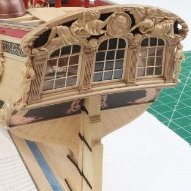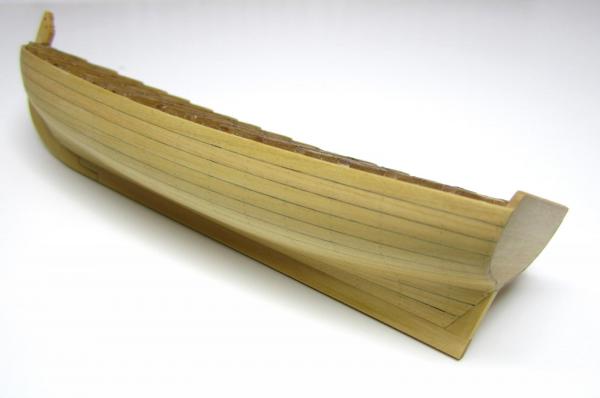-
Posts
9,637 -
Joined
-
Last visited
Content Type
Profiles
Forums
Gallery
Events
Everything posted by Chuck
-
Thats a loaded question...It really depends on the original thread brand and material you use. In addition...it will also depend on how tightly you lay up the rope. There are many factors. The best way is to just find a bunch of thread and experiment. Experiment with various timing to control the tightness of the lay. Chuck
-
looks good but go thinner with the cap rail....a little more oatboard and a little more inboard. The thinner the better. Chuck
- 175 replies
-
- 18th century longboat
- model shipways
-
(and 1 more)
Tagged with:
-
Dont buy the paint set...just buy the three colors you mentioned there....
- 175 replies
-
- 18th century longboat
- model shipways
-
(and 1 more)
Tagged with:
-
Yes you can get a good spray-on matte fixative but it can be expensive. A good alternative would be to use any hairspray you can find. Its cheaper and basically the same stuff. If you find one with a UV protection it will actually help prevent the ink from fading. This is what I use. Spray a light coat first and then apply to more heavier coats. But dont soak it as the ink will probably spread. Chuck
- 175 replies
-
- 18th century longboat
- model shipways
-
(and 1 more)
Tagged with:
-
Looking good Augie. Should you choose another treenail pattern remember to still go small. Anything larger than a #78 drill bit would probably be too large and historically inaccurate. Although it is a matter of personal taste. Going with Bob's pattern is also not accurate so its just a matter of going with what you like. You dont want the model to look like it has the measles. But thats a long way off. Try a few tests on some scrap first. Chuck
- 2,191 replies
-
- confederacy
- Model Shipways
-
(and 1 more)
Tagged with:
-
Thats really coming together Rusty, Very clean and the wood colors look very good. Chuck
- 421 replies
-
- granado
- bomb ketch
-
(and 2 more)
Tagged with:
-
Augie, The planking is looking really good. One thing to watch is when you are ready to place the second layer of the wales (both of them) on top of the first layer. If your planking run isnt identical at the stern where the planks run off the hull, dont just follow that first layer with the wales. Make some adjustments on one side or the other so the wales are even port to starboard. Should they not be even it will cause you some problems when trying to get the quarter galleries built and the PE decorations on. The same is true at the bow when it comes time to make the headrails much later. Try and measure down from the cap rail on both sides after taking the measurements from the plans. You have a bit of wiggle room there if you need to adjust them to make them even. Just giving you something else to worry about!!!! and I hope you find it helpful. Chuck
- 2,191 replies
-
- confederacy
- Model Shipways
-
(and 1 more)
Tagged with:
-
That is better and I did the same by making the sheer curve more towards the middle. That is more in line with teh 1750's and 60's. The straighter sheer is more in line with those boats made much later. Chuck
- 175 replies
-
- 18th century longboat
- model shipways
-
(and 1 more)
Tagged with:
-
Yes you do....But not just at the stern..The whole bulwark should be lowered by about 1/16" give-or-take. Its hard to tell from your photos though. I would look at the other logs and my prototype and do a comparison. Its hard to tell at this point with the tops of the frames flush with the planking. Having not started the planking at the top to establish the proper sheer line I think the one you ended up with is quite arbitrary. This is what caused the issue. You can see how much of the frames remained above the planking on the prototype....the transom sticks up much higher. But its not just your stern..Its whole length needs to be shorter. This is a good opportunity to draw a nice graceful curve of a sheer line and then file down to it. Chuck
- 175 replies
-
- 18th century longboat
- model shipways
-
(and 1 more)
Tagged with:
-
I am not sure where he got his but you can them pretty small at a place that sells them for eyeglasses. Just do a google search and you find some real tiny screws. smaller even than are used typically for glasses.
-
That is quite a change from the sticks and strings. I have never modeled a steel hull so I will watch with interest. From what I understand these types of models are all about the paintwork ans finishing. Jim H (captainPugwash) is very skilled at that sort of thing if you need some tips with new materials. Chuck
- 382 replies
-
- stadacona
- sylvan scale models
-
(and 1 more)
Tagged with:
-
Well done on the skylight Tex.
- 2,250 replies
-
- model shipways
- Charles W Morgan
-
(and 1 more)
Tagged with:
-
That looks very god Chris. The painting of the trailboard and the figurehead are especially good and blend in very well with the wood.
- 290 replies
-
- confederacy
- frigate
-
(and 1 more)
Tagged with:
-
It is looking good. Just as the others mentioned you should shorten the length of the garboard quite a bit. Otherwise the remaining planks will need to be tapered too much along the stem. I show in red the approximate amount. I would suggest after the garboard plank is in place that you divide up the remaining space at each bulkhead so you can see just how the remaining planks will run and how much they need to taper. Use a tick strip at the widest point of the opening midship to determine how many planks you will need. Once you know how many planks will fit at that widest point you can mark the width of that number of planks at every bulkhead in the opening. This will show you exactly how the planks will run and how much they need to be tapered. Im guessing you will probably need six more plank strakes to complete that side of the hull once the garboard is in position. Chuck
-
I used a dremel with sanding drum...the small sanding drums. The frames were taken down almost to the right size. It leaves a very rough and irregular finish but does the job and you need to be very careful and use a light touch. Then the sanding sticks and other folded pieces of sandpaper cleaned it up. You have to get those frames pretty thin towards the top so the caprail isnt too wide. It will make the model look heavy and chunky. Making it thin gives the model a light and delicate feel. Chuck
- 175 replies
-
- 18th century longboat
- model shipways
-
(and 1 more)
Tagged with:
-

Announcing the Model Ship World Ship Kit Database Project
Chuck replied to SkerryAmp's topic in Wood ship model kits
I have placed a banner on the right side of the forum and also on the MSW home page...this will ensure easy access moving forward. Adam has been working very hard on this and it will soon be the go to place to find info about ship kits. This will replace that spreadsheet Floyd was referencing. All of us on MSW thanks you..please give Adam any help you can with this if it is at all possible. Wonderful work Adam Chuck -
If you buy the sherline...be prepared to build it yourself. It comes in many many pieces that needs to be assembled. The microlux just comes in two pieces. You basically have to build the entire casing for the mill when you buy the Sherline. Chuck
-
I have the 5400...... It can be bought here the cheapest that I have seen. There is an instant $25 coupon and free shipping. http://www.discountcampus.com/cgi-bin/webc.exe/store/st_prod.html?p_prodid=4615 Its about $700 In comparison, the Mocrolux is $500 plus about $45 for shipping....It would have also been some additional sales tax in NJ for me so the cost difference for me was only about $130 For you it would be only about $150 more for the Sherline but you then have to spend $$ on hold down clamps and endmills....the endmill chuck etc....the same is true if you bought the Microlux.
About us
Modelshipworld - Advancing Ship Modeling through Research
SSL Secured
Your security is important for us so this Website is SSL-Secured
NRG Mailing Address
Nautical Research Guild
237 South Lincoln Street
Westmont IL, 60559-1917
Model Ship World ® and the MSW logo are Registered Trademarks, and belong to the Nautical Research Guild (United States Patent and Trademark Office: No. 6,929,264 & No. 6,929,274, registered Dec. 20, 2022)
Helpful Links
About the NRG
If you enjoy building ship models that are historically accurate as well as beautiful, then The Nautical Research Guild (NRG) is just right for you.
The Guild is a non-profit educational organization whose mission is to “Advance Ship Modeling Through Research”. We provide support to our members in their efforts to raise the quality of their model ships.
The Nautical Research Guild has published our world-renowned quarterly magazine, The Nautical Research Journal, since 1955. The pages of the Journal are full of articles by accomplished ship modelers who show you how they create those exquisite details on their models, and by maritime historians who show you the correct details to build. The Journal is available in both print and digital editions. Go to the NRG web site (www.thenrg.org) to download a complimentary digital copy of the Journal. The NRG also publishes plan sets, books and compilations of back issues of the Journal and the former Ships in Scale and Model Ship Builder magazines.




